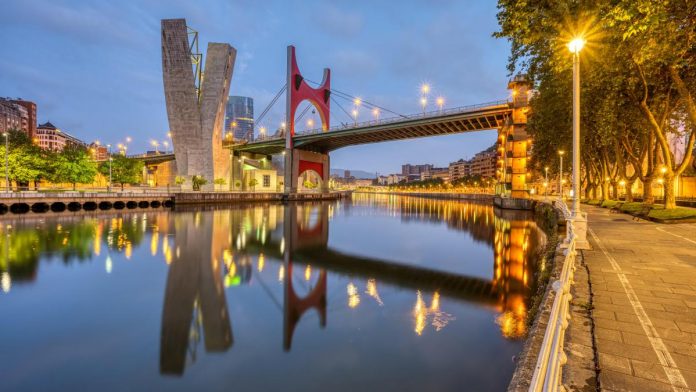flamenco? Risk of sunburn? Long sandy beaches? This may be typical of many a Spanish region on the Mediterranean, but not for Bilbao, which has around 350,000 inhabitants. In the autonomous Basque Country, not only the (Atlantic) wind is rougher, but also the landscape, and some say: the character of the people. The 1970s and 1980s, when the port city suffered from extreme unemployment, may have contributed to this.
But then Bilbao experienced an amazing turnaround. Shipyards and industrial ruins disappeared, a metro appeared. It connected the parts of the city scattered around the mouth of the Nervión river. The shell-shaped metro entrances created by Sir Norman Foster, known as “Fosteritos”, have also become design icons.
By no means an isolated case, a series of lighthouse objects emerged: from Santiago Calatrava’s chalk-white, light airport building and its graceful Zubizuri Bridge to the neo-urban residential towers of the Japanese Arata Isozaki to the Palacio Euskalduna. This event building, which was created from an unprofitable shipyard and whose shape is reminiscent of a ship, was even ennobled in 2003 as the world’s best congress center.
Pablo Picasso at the Guggenheim Museum
The flagship of the boom, however, is the Guggenheim Museum for contemporary art. The fact that it not only became a symbol of Bilbao, but also one of the most famous museums in the world, was due not only to the art inside the building but also to the outside. In 1997, star architect Frank Gehry anticipated the future with the sweeping, glittering titanium building.
Fascination and the stream of visitors are unbroken, also thanks to top-class special shows. 2023 is a special one. The exhibition “Matter and Body” (originally: “Picasso escultor. Materia y cuerpo”) is dedicated to the artist Pablo Picasso on the 50th anniversary of his death. Lucía Agirre, who has a large part in it as co-curator, is pleased: “The selection of sculptures presents the almost infinite variety of languages and materials that the artist uses to represent the human body form”.
Good to know: The exhibition, which runs from the end of September to January, is the first comprehensive exhibition of Picasso’s sculptural work in Spain. “In addition,” says the 52-year-old Agirre, who was born and lives in the greater Bilbao area, “this is the very first Picasso exhibition in the Basque Country”.
Bilbao combines tradition and modernity
If you’re looking for young (and wild) culture, you’ll find it elsewhere too, such as in the converted warehouses at ZAWP in the Zorrotzaurre district, which offers live music, workshops and underground art. Another hotspot for bohemian shops, boutiques, second-hand shops and bars are the Siete Calles, the heart of the old town quarter.
In the seven streets of the Casco Viejo, renovated after the devastating flood of 1983, traditional and modern shops alternate with numerous restaurants. Right in the middle: the Art Nouveau music pavilion designed by the architect Pedro Ispizua, where the city band plays every Sunday.
Other highlights include the 14th-century Gothic cathedral, the Basílica de Nuestra Señora de Begoña, the venerable Teatro Arriaga and the nearly 100-year-old Mercado de la Ribera. Europe’s largest covered market at 10,000 square meters is something of the soul of Bilbao, thanks to plenty of food stalls, gastronomy, jazz music and an eclectic building style that doesn’t have any pillars.
In contrast, top architect Philippe Starck relied on 43 individually designed columns when redesigning the Azkuna Zentroa into a center for contemporary art and leisure.
Relax on the banks of the Nervión River
The right bank of the river is a center of well-being for Agirre: “I love Sunday mornings there in particular, do some shopping at the flower market in front of the town hall, have breakfast on the Plaza Nueva and then go for a walk along the Nervión before going out for a drink with friends, like in the Abando district.”
Specifically: “The ‘EME Bar’ and its unique sandwiches are a dream; also Don Manuel’s pastries, like a Carolina or a Bollo de Mantequilla, both typically Bilbao! This also includes going to the opera or a match at the Estadio San Mamés.”
Incidentally, only footballers who come from the Basque Country or were trained there are allowed to play in the extremely popular Athletic Club. This shows self-confidence and creates identification. You can imagine the atmosphere!
Those who prefer to be active themselves will find plenty to do in numerous parks. The slopes, which can be reached quickly on foot from the center, offer a unique view of the city, with the paths in the hilly hinterland going one better, and even more so the trails on the rough coast.
The sea can be reached quickly anyway thanks to the metro. The fact that surfers like to meet in Sopelana, for example, indicates regular winds. When these subside and the sun has a clear path, there is definitely a bathing mood – including the risk of sunburn.
More tips and information:
Guggenheim Museum: Open daily from 10am to 8pm; the exhibition “Picasso escultor. Materia y cuerpo” will take place from September 29th to January 14th, 2024; guggenheim-bilbao.eus
Restaurants: “Asador Etxebarri“: Food lovers from all over the world vie for seats in the restaurant located outside of Bilbao. No wonder: It ranks third in the “World’s 50 Best” list (asadoretxebarri.com).
“Zortziko”: Star chef Daniel García serves modern interpretations of Basque specialties – in an extraordinary, classical ambience in the middle of Bilbao (zortziko.es).
Accommodation: Hotel “Ercilla”: If you like the Guggenheim Museum, you will also enjoy this modern four-star hotel. Not just because it’s nearby, but also because of the art by Philippe Starck and Ingo Maurer on display here (ercilladebilbao.com). Artists are also at work in the “99 Sushi Bar & Restaurant” next door (99sushibar.com/99-sushi-bar-bilbao/).
“Gran Hotel Domine”: Unusual luxury hotel opposite the Guggenheim Museum. Each area is designed according to a specific era: Bauhaus, 1960s, 1990s minimalism. Sublime: the rooftop terrace (hoteldominebilbao.com).
Additional Information: bilbaoturismo.net; bilbao.eus


